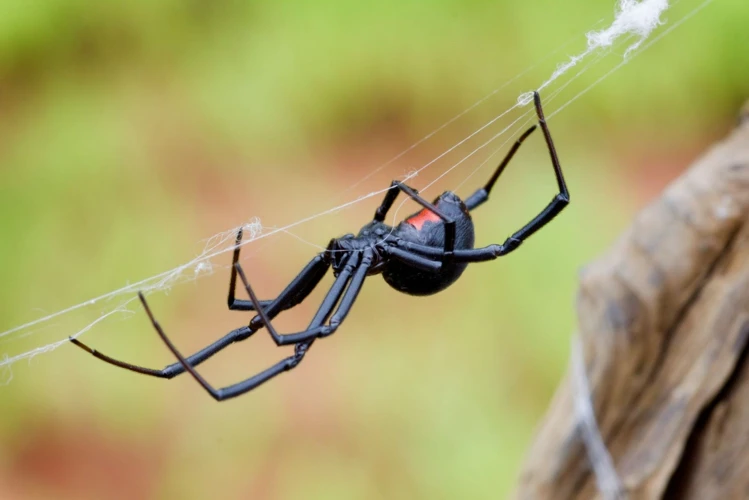Introduction
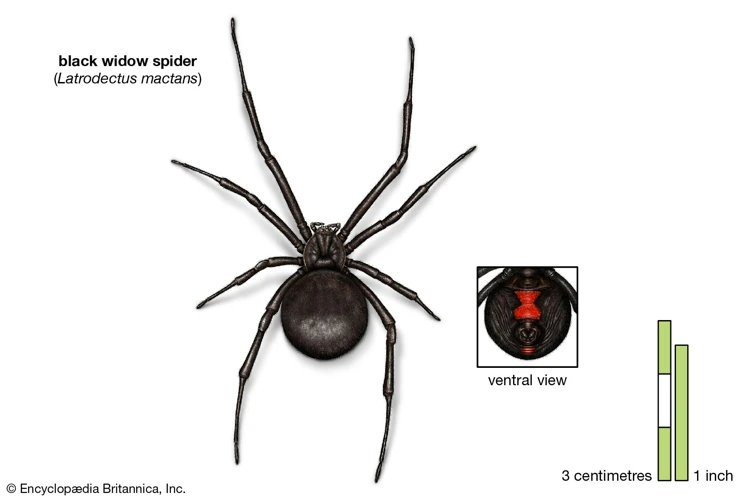
As humans, we often marvel at the elaborate mating rituals of animals. From the dance of the peacock to the song of the whale, we are fascinated by the intricate courtship displays that take place in the animal kingdom. Among these displays, the courtship ritual of the black widow spider stands out as one of the most complex and intriguing. With its high stakes and intense physical interactions, black widow spider courtship is a true dance of life and death that has captivated researchers and casual observers alike. Join us as we dive into the world of the black widow spider and explore the risks, rewards, and mysteries of its courtship ritual.
The Basics of Black Widow Spider Mating
During black widow spider mating, the male must be cautious in his approach due to the female’s aggressive nature. Unlike many other species, male black widows risk their lives during courtship. The male will initiate courtship by tapping the spider’s web to signal his presence. If the female is receptive, she will then allow the male to approach. Once close, the male will slowly begin to wrap his mate in silk, in hopes of immobilizing her. This wrapping process is referred to as ‘spider binding’.
When the wrapping is complete, the male will mount the female to deposit his sperm. The entire process may take a few hours or even days, depending on the species. However, the male’s job is far from over. After he mates, he may become a victim of cannibalism at the hands of his mate.
Male black widow spiders have an inherent biological drive to mate, and will risk their lives to ensure the survival of their species’ genetic material. But the female is in control, and she has the power to choose her mate based on genetics and physical traits.
Black widow spider mating is influenced by environmental factors such as temperature, humidity, and lighting. These factors can affect mating behaviors and even the number of viable offspring produced.
Despite the risks associated with black widow spider mating, it is an essential aspect of their reproductive cycle. By understanding the basics of black widow spider reproduction and the behaviors associated with it, researchers can begin to unravel the complexities of this species’ fascinating courtship ritual.
The Importance of Understanding Black Widow Spider Courtship
Understanding the courtship ritual of black widow spiders is of great importance for multiple reasons:
- Preventing male death and cannibalization: Black widow spider mating has been associated with high risk of death and cannibalization. By understanding the courtship dynamics, male fatalities can be minimized. Check out our article on male black widow spider mating cannibalization for more information.
- Exploring environmental factors: Environmental factors such as lighting, temperature, and habitat have an impact on black widow spider mating. By understanding these factors, better management techniques can be developed. For more details, read our article on environmental factors and black widow mating.
- Understanding female aggression: Understanding female aggression can help us understand how to reduce aggression during black widow spider mating. Our article on female aggression during black widow spider mating can give you an insight into this.
- Resolving black widow spider mating conflicts: Understanding the behavior and physiology of black widow spiders can help resolve mating conflicts within the species. Read our article on mating conflicts in black widow spiders for more information.
- Appreciating the role of genetics in mate choice: Genetic diversity is critical to the survival of a species. Understanding how black widow spiders choose their mate can help us appreciate the role genetics play in mate choice. Learn more in our article on black widow mate choice and genetics.
In addition to these, understanding the intricate dance of black widow spider mating can help us appreciate the beauty and complexity of nature’s courtship rituals. For more information on this, check out our article on black widow spider mating behavior.
The Risks and Rewards of Black Widow Spider Mating
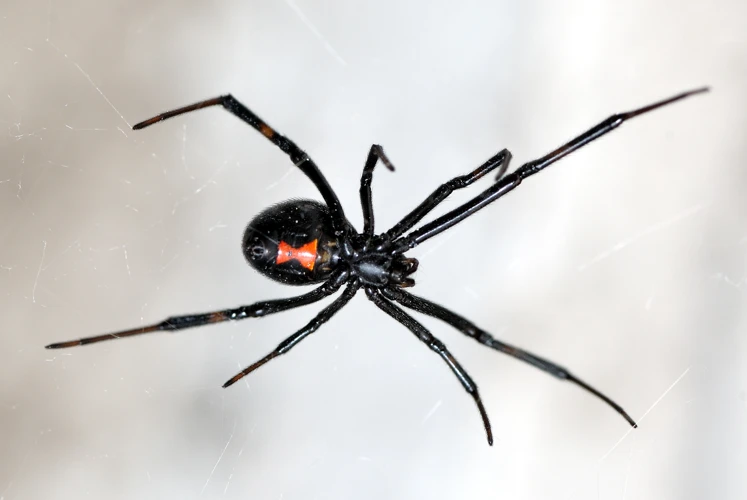
Black Widow Spider mating is not for the faint of heart. These arachnids engage in a dangerous dance that can end in both life and death. However, there are also certain rewards to be gained from this risky behavior. It is important to understand the risks and rewards associated with Black Widow Spider mating to appreciate the intricacies of their courtship ritual. Let’s explore the dangers and benefits these spiders face while fulfilling their innate biological drive.
The Risks: Potential for Death and Cannibalization
The risks associated with black widow spider mating are significant. For male black widow spiders, the potential for death and cannibalization looms large. During mating, the male must make himself vulnerable to the female’s advances, hoping that she will accept him as a suitable mate rather than prey.
Here are some of the risks male black widow spiders face during mating:
- Male Sacrifice: One of the most extreme risks for male black widow spiders during mating is the possibility of being sacrificed by the female. In some cases, the female may kill and consume the male during copulation, a behavior known as sexual cannibalism. This sacrifice is not uncommon among black widows and other spider species, and it highlights the high level of risk involved in spider reproduction. Scientists believe that the sacrifice may increase the male’s reproductive success, as it enables the female to produce more eggs.
- Pre-Mating Aggression: In addition to the risk of cannibalization during mating, male black widow spiders may also face aggression from females prior to copulation. Females are often aggressive towards males, leading to physical attacks that can result in injury or death. Males must be prepared to avoid or defend against these attacks in order to survive long enough to mate.
While the risks of mating are high for male black widow spiders, the rewards of successful reproduction can also be significant. Researchers have found that male ornamentation, reproductive success, and prey selection can all play important roles in determining a male’s fitness as a mate. Understanding the risks and rewards of black widow spider mating is critical for understanding the dynamics of spider reproduction and the evolution of sexual strategies in nature.
Studies have shown that male sacrifice during mating can actually improve a male’s reproductive success. By sacrificing himself to the female, the male may enable her to produce more eggs, resulting in a higher number of offspring. This strategy may help to promote genetic diversity and increase the success of future generations of black widow spiders.
The risks of black widow spider mating are significant, but they are ultimately outweighed by the potential rewards of successful reproduction. By understanding the complex dynamics of spider courtship and reproduction, researchers can gain valuable insights into the intricacies of nature’s most fascinating and perplexing courtship rituals.
The Rewards: Promoting Genetic Diversity and Successful Offspring
One of the rewards of black widow spider mating is the promotion of genetic diversity and successful offspring. Black widow females tend to mate with multiple males, which can increase the genetic variation of their offspring. This genetic diversity can help ensure the survival of the species, as it allows for greater adaptability to changing environmental conditions.
Research has shown that male black widows who possess certain traits, such as larger body size and brighter coloration, have higher reproductive success rates. These traits may indicate genetic quality, making them desirable in a mate choice scenario. In fact, female black widows have been observed to selectively mate with males who possess these traits, indicating a preference for genetic quality.[1]
However, successful reproduction in black widow spiders is not solely dependent on genetic factors. Males who survive the courtship ritual and successfully copulate with a female also have higher reproductive success rates. This is because female black widows have been observed to cannibalize males after mating. However, males who are able to avoid being cannibalized can go on to mate with additional females and increase their chances of passing on their genes. [2]
Although male black widows face the risk of cannibalization during courtship and mating, the potential reward of successful reproduction and passing on their genes makes the risk worth taking. Research has also shown that males who offer prey items to females during courtship have a higher chance of successful copulation. This may be because the prey item provides a distraction for the female, allowing the male to avoid being attacked. [3]
The rewards of black widow spider mating include the promotion of genetic diversity and the potential for successful reproduction and passing on of genes. However, the risks of cannibalization during courtship and mating can be significant for males. Despite these risks, many males still participate in the courtship ritual in order to increase their chances of successful reproduction and passing on their genes.
| Rewards of Black Widow Spider Mating |
|---|
| Increase in genetic diversity of offspring |
| Greater adaptability to changing environmental conditions |
| Higher reproductive success rates for males with desirable traits |
| Potential for successful reproduction and passing on of genes |
The Intricate Dance of Black Widow Spider Mating
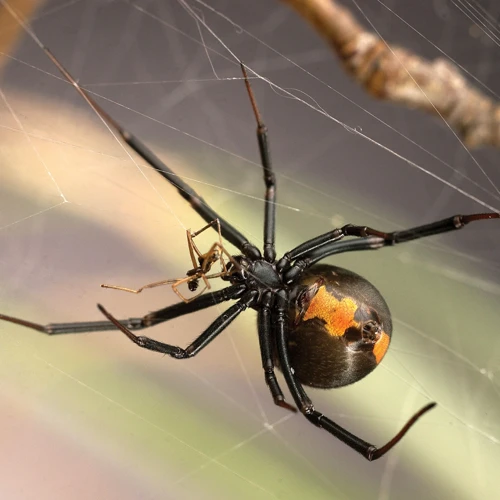
As you observe the courtship ritual of black widow spiders, be prepared to witness an intricate dance of life and death – a complex yet beautiful spectacle that showcases the mating behavior of these notorious arachnids. From the male’s seduction tactics to the female’s evaluation process, every step of the courtship dance has a purpose that could mean the difference between successful copulation and untimely demise. In this section, we delve deeper into the fascinating world of black widow spider mating and explore the mesmerizing intricacies of their courtship ritual.
The Male’s Seduction Tactics: Vibrations, Wrapping, and Offerings
Male black widow spiders have developed several tactics for seducing females during courtship, each involving intricate behaviors and movements. These tactics aim to persuade females to mate with them by proving their worthiness and desire. Below are some of the male’s seduction tactics:
- Vibrations: The male spider will create vibrations on the female’s web to get her attention. He may pluck or tap on specific strands, creating a rhythmic pattern that is meant to entice the female to emerge from her hiding place and investigate. This tactic requires significant finesse on the part of the male, as too many vibrations may be seen as aggressive and too few will not be enough to attract the female.
- Wrapping: Once the female is out of hiding, the male will approach her cautiously and begin wrapping her in silk. This activity is called web-binding and is meant to immobilize the female, making it easier for the male to mate. At the same time, the silk may contain chemicals that help calm the female or suppress her aggressive instincts, making her more receptive to mating.
- Offerings: In some cases, male black widow spiders will bring a gift for the female, such as a fly or another small insect, as an offering. This gesture is meant to show the female that the male is a good provider and worth mating with. The female may accept the gift and consume it during the mating process, potentially benefiting from the additional nutrients and energy.
These tactics show just how calculated and strategic male black widow spiders are when trying to woo females. While they may seem strange or even unsettling to humans, they are critical to the survival of the species and have been refined over millions of years of evolution.
The Female’s Evaluation Process: Testing Strength and Resilience
When it comes to black widow spider courtship, the female plays a crucial role in evaluating potential mates. Her evaluation process involves testing the male’s strength and resilience, as she seeks out a partner who can provide strong genetics for her offspring.
The evaluation process can be broken down into several steps:
- Size comparison: The female black widow spider will often begin by assessing the size of the male. She will compare his size to hers, and if he appears small or weak, she may reject him outright.
- Vibrations: Next, the male will begin to vibrate the web, sending signals to the female that he is a potential mate. The female will pay close attention to the vibrations, evaluating their strength and intensity to determine the male’s fitness.
- Wrapping: If the female is interested, the male will approach her and begin to wrap her in silk. This serves two purposes – it helps to immobilize the female and prevent her from attacking, and it also allows the male to get closer to the female in order to mate.
- Persistence: Throughout this stage, the female may attempt to resist the male’s advances. She may struggle and try to break free, testing his persistence and ability to woo her.
- Escape: Finally, if the male is able to successfully mate with the female, he must make a quick escape to avoid being cannibalized. The female may still view him as a potential threat, and if he lingers too long, she may attack and consume him.
It is important to note that this evaluation process is not a foolproof method for ensuring the success of the courtship. Even if the male passes the female’s tests, there is still a high risk of cannibalization and death. However, this process does allow the female to choose a mate who is strong and resilient, increasing the chances of producing successful offspring.
The Climax: Copulation and Sacrifice
As the male black widow spider begins the copulation process, he must be cautious not to alert the female to his true intentions. In order to avoid triggering her predatory instincts, he continues to vibrate his legs and wrap himself around her, all while slowly moving closer to her genital opening. Once he has successfully inserted his pedipalps, the male will proceed with fertilization.
Unfortunately for the male, copulation with the female black widow spider comes at a steep cost. Despite his best efforts to appease and distract her, there is always a chance that the female will still perceive him as a threat and begin to attack. In many cases, the male will even willingly sacrifice himself in order to allow his offspring the best possible chance at survival.
This practice, known as sexual cannibalism, is a common occurrence among black widow spider species. By consuming her partner, the female gains valuable nutrients that allow her to produce and care for healthy offspring. Additionally, this ensures that the father’s genetic material is passed on to the next generation, increasing overall genetic diversity within the species.
Despite the seemingly gruesome nature of this practice, it is important to remember that such behavior has evolved over millions of years as an effective reproductive strategy. As we continue to study and learn more about the intricate courtship rituals of black widow spiders, we may come to appreciate just how complex and intricate the natural world truly is.
To summarize, copulation in black widow spiders is a careful and cautious process that often results in the male spider sacrificing himself to ensure the survival of his offspring. Sexual cannibalism, while gruesome, is a common occurrence that has evolved over time as an effective reproductive strategy. By consuming her partner, the female is able to gain valuable nutrients and increase overall genetic diversity within the species.
Black Widow Spider Courtship Across Species
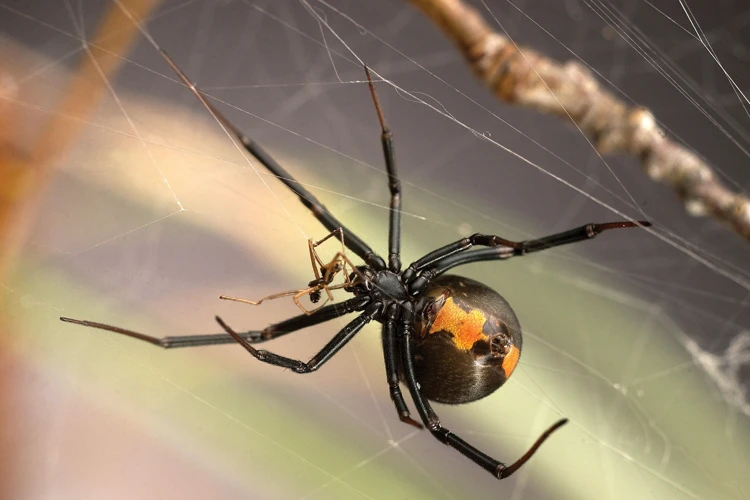
While black widow spiders are known for their distinctive courtship rituals, the specifics of these behaviors can vary between different species. It’s fascinating to observe the varied approaches to seduction and defense across the black widow family. From the male’s seduction tactics to the female’s evaluation process, each species has its own unique courtship dynamics. Let’s take a closer look at these differences and the implications they have for our understanding of these dangerous yet captivating arachnids.
Varied Approaches to Seduction and Defense
When it comes to black widow spider courtship, there is no “one size fits all” approach. Male black widows have developed a variety of techniques to successfully seduce females from different species and defend themselves from potential attacks.
Vibrations: One common tactic used by male black widows is to produce vibrations on the female’s web to attract her attention. These vibrations can vary in frequency and amplitude depending on the species of spider, and some males have even developed specialized appendages to produce more complex vibrations.
Wrapping: Another approach is for the male to physically wrap the female in silk to subdue her and prevent her from attacking. This strategy is often used by males of larger black widow spider species who may be at greater risk of cannibalization.
Offerings: Some male black widows have taken a different approach and bring an offering to the female in the hopes of winning her favor. It could be a tasty insect or even a portion of their own silk to help construct a new web. This behavior has been observed in some species of black widows, where the female may be more likely to mate with males who bring gifts.
It’s not just male black widow spiders that have developed varied approaches to mating. Female black widows have also developed unique defensive behaviors, such as aggressive posturing to ward off potential suitors. In some species, females may even mimic the behaviors of male spiders to prevent attacks.
Black widow spider courtship is a complex and multifaceted process that varies greatly between different species. By studying these behaviors and interactions, researchers can gain a greater understanding of the intricacies of animal behavior and the ways in which different species have evolved to survive and reproduce in their respective ecosystems.
Diversity in Courtship Duration and Copulation Success
Black widow spider courtship rituals vary greatly in duration and success rates across species. For example, in the Western black widow, courtship can last for several hours before copulation occurs, while in the Northern black widow, it may only last a few minutes. (Note: these spiders are highly venomous and dangerous. Do not attempt to approach or handle them.)
Interestingly, studies show that the duration of courtship may not necessarily correlate with copulation success. In some cases, longer courtship periods resulted in a higher likelihood of successful copulation, while in other cases, shorter courtship periods were actually more successful.
The males of some black widow spider species have developed unique tactics to increase their chances of successful mating. For example, male Southern black widows will sometimes approach a female while she is eating prey, and wrap his body around hers, preventing her from feeding and reducing her aggression towards him.
However, even with these tactics, copulation success rates are often low due to the high risk of cannibalism from the female. In some species, up to 80% of males are cannibalized by the female after mating.
The diversity in courtship duration and copulation success among black widow spider species highlights the complexity of their mating rituals and the different strategies that have evolved. Further research into these strategies and their effectiveness could have important implications for understanding the evolution of mating behaviors in other species as well.
The Future of Black Widow Spider Courtship Research
As we delve deeper into the intricacies of black widow spider courtship, there is no doubt that much more awaits discovery. The future of research in this field holds many exciting possibilities, from gaining a deeper understanding of the physiological and behavioral processes involved in mating, to exploring new ways to mitigate the dangers of black widow spider infestations. Join us as we take a closer look at the path ahead, brimming with opportunities to further our knowledge of this fascinating species.
Continued Study into Mating Dynamics and Reproductive Strategies
As experts continue to unravel the mysteries surrounding the courtship rituals of black widow spiders, it is clear that there is still much to learn about their mating dynamics and reproductive strategies.
One area of ongoing research is the role of pheromones in the courtship process. Male black widow spiders have been observed releasing pheromones to attract females, but the exact chemical composition and effects of these pheromones are still being studied. Understanding pheromones could lead to the development of more effective pest control strategies or even the creation of synthetic pheromones to manipulate spider behavior.
Another area of interest is the influence of environmental factors on black widow spider mating behavior. Researchers have observed differences in courtship and mating behaviors between populations living in different regions, but the reasons for these differences are not fully understood. Some scientists are investigating how temperature and humidity may impact mating behavior, while others are studying how the availability of food or resources could affect reproductive strategies.
There is ongoing research on the genetic and anatomical factors that may affect black widow spider mating success. Studies have shown that relatedness between mating partners can have an impact on the success of offspring, as well as the potential for inbreeding. Additionally, researchers are investigating how the size and condition of male and female spiders may impact courtship behavior and reproductive success.
All of these areas of study are essential for gaining a comprehensive understanding of black widow spider mating dynamics and reproductive strategies. By continuing to explore these topics, researchers can gain insights into a wide range of topics, from the evolution of sexual behavior to the management and conservation of diverse ecosystems.
| Areas of Ongoing Research |
|---|
| Pheromones: investigating the chemical composition and effects of male black widow spider pheromones for attracting females |
| Environmental Factors: studying how temperature, humidity, and resource availability may impact black widow spider mating behaviors |
| Genetic and Anatomical Factors: exploring how relatedness, size, and condition of mating partners can impact courtship behavior and reproductive success |
Implications for Pest Control and Biodiversity Conservation
The study of black widow spider courtship has important implications for pest control and biodiversity conservation efforts. As predators, black widow spiders play a crucial role in maintaining ecological balance, but when their populations become too abundant, they can also pose a threat to human health and safety.
Pest Control: Understanding the courtship behavior of black widow spiders can help pest control professionals develop more effective methods for managing their populations. One potential strategy involves disrupting the male’s ability to seduce the female through the use of pheromone traps or other scent-based deterrents. Additionally, by identifying and removing black widow spider egg sacs before they hatch, pest control experts can help to keep their numbers in check.
Biodiversity Conservation: Black widow spider courtship also has important implications for biodiversity conservation efforts. By promoting genetic diversity through successful reproduction, black widow spiders help to maintain the health and resilience of their species. Understanding the factors that contribute to successful courtship and reproduction can help conservation biologists identify and protect key habitats and ecosystems that support black widow spider populations.
To further illustrate these implications, the following table outlines some of the potential benefits and challenges associated with black widow spider control and conservation efforts:
| Pest Control | Biodiversity Conservation | |
|---|---|---|
| Benefits | Reduces risk of human injuries or fatalities | Helps maintain balance in local ecosystems |
| Challenges | May harm non-target species if not managed correctly | May be viewed as a nuisance or danger by humans |
As this table demonstrates, there is a delicate balance to be struck between maintaining healthy populations of black widow spiders and mitigating the risks they may pose to humans and other species. Through continued research and collaboration between pest control professionals, conservation biologists, and other experts, we can work towards a more sustainable and balanced approach to managing black widow spider populations.
Conclusion
As we come to the end of our exploration into the courtship ritual of black widow spiders, it’s hard not to be left in awe of the intricacies and nuances of their fascinating mating behavior. Through the risks and rewards of their encounters, and the seductive dance that ensues, black widow spiders showcase the beauty and complexity of nature’s courtship rituals. Understanding the dynamics of their mating not only sheds light on their unique biology but also has implications for pest control and biodiversity conservation. Let’s dive deeper into the significance of it all.
Why Understanding Black Widow Spider Mating Matters
Understanding the courtship and mating behavior of black widow spiders is essential for various reasons. Let’s explore some of them:
- Ecological Significance: Black widow spiders play a crucial role in the ecosystem as both predators and prey. Their mating behavior affects their population dynamics and genetic diversity, which, in turn, can have ripple effects on the food chain.
- Control and Prevention: Black widow spiders are infamous for their venomous bites, which can be fatal for humans. Understanding their courtship behavior can help pest control professionals develop effective strategies for managing their populations and reducing the risk of human encounters.
- Biodiversity Conservation: As with any species, maintaining the genetic diversity of black widow spiders is important for their long-term survival. Studying their courtship behavior can provide insights into how they select mates and promote genetic diversity in their offspring.
- Scientific Curiosity: Beyond the practical applications, understanding the courtship ritual of black widow spiders is fascinating from a scientific perspective. Their behavior is intricate and complex, and studying it can help us appreciate the beauty and diversity of nature’s courtship rituals.
Understanding black widow spider mating matters not just for practical reasons but also for a deeper appreciation of the intricate dance of life and death that takes place in the animal kingdom.
Appreciating the Beauty and Complexity of Nature’s Courtship Rituals
As fascinating and intricate as the courtship ritual of black widow spiders may be, it is just one of many examples of the beauty and complexity of nature’s courtship rituals. From birds performing elaborate dances to impress their partners, to fish changing colors and patterns to signal their readiness to mate, the natural world is full of stunning displays of courtship.
Species | Courtship Ritual | Description
— | — | —
Peacock Spider | Vibrant Dances | Male spiders give elaborate courtship performances complete with rhythmic body movements and brightly colored flaps of skin.
Birds of Paradise | Elaborate Dances | Male birds have intricate dances that involve impressive displays of feathers, vocalizations, and movements.
Mantises | Cannibalistic Courtship | The female praying mantis will sometimes devour the male following copulation, making the process a matter of life or death.
Anglerfish | Bioluminescent Lures | Deep-sea anglerfish have bioluminescent lures on their heads that they use to attract prey and mates alike.
Fireflies | Light Displays | Male fireflies produce light to attract female mates, creating stunning natural light shows.
Octopuses | Arm-to-Arm Courtship | Male octopuses will display deep colors and intricate patterns with their arms to attract female mates and engage in arm-to-arm courtship.
These courtship rituals are not only aesthetically pleasing, but they also serve crucial functions in ensuring successful reproduction and maintaining genetic diversity within species. By appreciating and studying these complex behaviors, we can gain a deeper understanding and appreciation of the natural world around us.
Frequently Asked Questions
What makes the black widow spider’s courtship ritual unique?
The black widow spider’s courtship ritual is unique because it involves a complex dance between the male and female spiders that can result in the male being cannibalized by the female.
Can black widow spiders be found in different parts of the world?
Yes, black widow spiders can be found in different parts of the world including Africa, Asia, Australia, Europe, North America, and South America.
What are the male black widow’s seduction tactics?
The male black widow uses vibrations, wrapping, and offerings to seduce the female.
How can a male black widow survive the courtship ritual?
A male black widow can survive the courtship ritual by continuously monitoring the female’s behavior and adjusting his approach accordingly.
What is the purpose of the black widow spider’s venom?
The purpose of the black widow spider’s venom is to immobilize and kill its prey.
Can black widow spiders reproduce without mating?
No, black widow spiders cannot reproduce without mating.
What is the role of genetic diversity in successful offspring?
Genetic diversity plays a crucial role in successful offspring by increasing the pool of traits that can help offspring adapt and survive in their environment.
How do black widow spiders defend themselves?
Black widow spiders defend themselves by biting their predators with their venomous fangs.
What are some implications for pest control with black widow spiders?
The study of black widow spider mating dynamics can help inform pest control strategies to help reduce their populations in areas where they may pose a threat to humans and other animals.
Why is understanding black widow spider courtship important?
Understanding black widow spider courtship is important for understanding predator-prey dynamics and the evolution of mating strategies in organisms.

